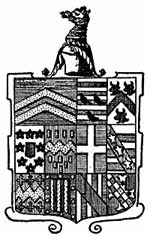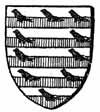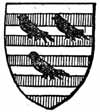Chaworth family
By Mrs L Chaworth Musters
 |
Arms over chimney-piece at Annesley. Crest:—BASSET OF WELLEDON. |
IN Mr. Round's "Calendar of Documents preserved in France," published 1899, occurs the following passage, p. xlviii., vol i.:—
"The race whose name was Anglicised as Chaworth, and Latinized as 'de Cadurcis,' 'de Chaorciis,' &c., has been derived diversely by our best authorities; Mr. Ellis and others identifying its name with that of the town of Cahors, while Mr. W. H. Stevenson traced it to a commune in the Somme. Its Stammhaus, however, was the Castle of Chaources, now Sourches, in the Commune of St. Symphorien, not far from Le Mans. Hence they are here found bestowing an English endowment on the stately Abbey of La Conture still standing, as they knew it, at Le Mans."
A history of "Le Chateau de Sourches (or Chaources) et ses Seigneurs," published at Le Mans in 1887, by the Due des Cars, the then owner, gives full particulars of the early history of this family, drawn from the charters still preserved in the archives of the modern chateau, which has replaced the feudal edifice pulled down in the 18th century.
[TRANSLATION.]
"The house of Sourches, or Chaources, or in English Chaworth, seems to have had its origin in that of Brizay in Touraine. We recall here one Meliadalus, or Meliardus, of the house of Caources, chancellor in the reign of Theodoric in the year 926.
This origin is mentioned in two ancient registers of arms of former times, one at the Celestins of Soissons, the other in the library of the Duke de Savelly in Italy. These two registers in the Chapter on the gentlemen of Maine who bore a banner, after having described the arms of Brizay (fasce d' argent et de gueules de huit pieces) say that lords of Sourches, 'puisne de Brizay,' added to the arms of these last an orle of ten martlets, 'pour brisure.' Louvet, in his 'Anciennes Remarques de la noblesse beauvoisin,' says that the war cry of the house of Brizay was 'Chaources' (no doubt from the name of the estate or family), as in the middle ages such war cries as 'Lancaster for the Earl of Derby,' 'A Home! A Home! A Home !' were well known.
 |
 |
Whatever may be the truth as to this origin, we find a family of Chaources established in Maine in the 11th century. A charter of La Couture in 1164 has 'In castello de Cadurcis extra primum et minorem fossam ejusdem castelli.' (Happily the exterior of the old chateau of Chaources is preserved for us in a curious lithograph, dated 1690, bearing the character of a castle of mediaeval times.) In the year 1050, Bouchard de Chaources was a witness to a donation made to the Priory of Laval.

Chateau de Chaources in 1690.
In 1063 the inhabitants of Maine had been forced to accept the Norman yoke, and we find Bouchard by the side of Duke William at the assizes at Domfront in 1064.
In the expedition, which two years later was to give William the possession of England, everything points to the belief that Bouchard or some member of his family was at the battle of Hastings. (The name of Chaworth is on the roll of Battle Abbey.)
The male line, that of Bouchard de Chaources, shortly became extinct, but from his brother, Hugh, who assured to the Abbey of La Couture the possession of Saint Mars sous Ballon, 1090-1096, descended the family which eventually settled in England. Patrice l' Ancien, son of Hugh, took the monastic habit in the Abbey of La Couture at Le Mans, and was succeeded by his son, Hugh, probably the witness to a deed relating to the Abbey of St. Vincent, 1085.
We now come to the second Patrice, or Patricius Chaworth, who married Avice or Hawisia de Londres,1 daughter and heiress of Thomas de Londres, lord of Ogmore and Kidwelly, in South Wales. The heirs of the family of Londres were obliged, by their tenure, to lead the army of the king, or his chief justice, from Neath to Lochor when they came into South Wales.
About 1126 Patricius and his wife, Matilda, gave to to the Abbey of La Couture at Le Mans for the salvation of their souls and the souls of their ancestors and their son, of Arnulf de Hodine the late Lord of Dodington, of William the Conqueror and of his son, Henry I., and of William Adeling (who was drowned in 1120 in the Blanche Nef on his way from Normandy), the church of Dodington2 in England. This gift was confirmed by Henry I. and Henry II., kings of England and dukes of Normandy. Patricius also gave to the monastery of St. Peter of Gloucester, four mills on his estate at Kemps-ford, in that county.
During the visit of Pope Urban II. to France in 1095, for the purpose of preaching the first crusade, Patricius and his son, Hugh, "were among the noblesse of Maine who raised the cry of 'Dieu le veut.'"
Patricius was succeeded by his son Payen, or Paganus Chaworth, by his wife, Avice de Londres. He possessed both the Chateau de Chaources, in Maine, and the strong Castle of Kidwelly,3 in Carmarthenshire, his mother's inheritance. He was a great benefactor to the monks of Blancheland and of Bottefant, near Southampton, and in 1158 accompanied Geoffrey de Mayenne on a fresh crusade. More than one hundred of the elite of the nobles of Maine, Anjou, and Brittany took part in the expedition, of whom only about thirty-five returned, but Pagan Chaworth was fortunate enough to be among them, as his name occurs in 1167, in a record of the abbey of La Couture."4...............
This account, abridged from the Duc des Cars' book, agrees fairly with Glover, but a mistake has been made in the marriage of Patrick, though it seems certain that the abbey of La Couture at Le Mans was benefited by Patricius and his wife, Matilda, in 1100-1122. How long the English Chaworths continued to hold property in France, as well as in England, is difficult to ascertain. Probably not after "Pagan surnamed of Mondoubleau," a town between Paris and Le Mans. He was the uncle of Matilda Chaworth, Countess of Lancaster, and according to the Duc des Cars, carried on the family from about 1224, till an heiress, the daughter of the fifth Patrick of Chaources, or Sourches, married Jean le Vayer before the year 1320.
In the church of Neuvillette, near the chateau of Sourches, is a tomb of the 13th century, supposed to be that of the knight Pagan de Sourches, or Chaworth. The warrior lies on his back with his hands joined, dressed in his mail, and at the end of the ogival niche is a figure of the Virgin holding a fruit in her left hand, while the right supports the infant Jesus on her knees. The Holy Child has a globe in his left hand, and his right is raised in the act of blessing the knight, who, in a long emblasoned robe, turns towards the Virgin in an imploring attitude. His wife prays by his side. The tomb below is now empty, but in 1850, some human bones were found there, which the Duc des Cars believed to be those of Payen, or Pagan, the crusader.
The pedigree drawn up by Glover for Sir George Chaworth in 1581 (to which we shall frequently refer), gives a charter from the register of the Priory of Dunstable, showing that this Patricius and his wife, Matilda, gave land at Chalton to that priory "for their souls and the soul of Ernulph their predecessor" (called also Ernulph de Hodine, or Hesling).
It would be too lengthy to relate here the story of the Chaworths as Lords Marchers, and their encounters with the Welsh. The Duchess of Cleveland gives an interesting account of them in her book on the Roll of Battle Abbey. That branch ended in an heiress, Matilda, born 1282, who carried the estates of the de Londres and the Chaworths to the house of Lancaster, by her marriage with Henry Plantagenet, Earl of Lancaster, nephew of King Edward I.5 By him she was the mother of a more famous Henry, "the good Duke of Lancaster," the flower of chivalry, Regent of Edward III.'s dominions in France, one of the first Knights of the Garter, whose grandson and namesake ascended the throne as King Henry IV.
The Duke died of the Black Death at Leicester in 1361. At Kempsford, in Gloucestershire, his horse's shoe is still nailed on the church door, and a grass terrace is known as "Maud's Walk," in remembrance of Maud or Matilda Chaworth, Countess of Lancaster, and mother of the "Good Duke."
"There is a well founded tradition," says Bigland's Gloucestershire, "that Kempsford was the site of a Royal Palace in the Saxon times, and that the Chaworths and Plantagenets resided in the castle there, which was rebuilt by Sir Thomas Thynne in the reign of James I."
Atkyn's Gloucestershire states that "Henry, Earl of Lancaster, succeeded to the barony of Kempsford, A.D. 1336. He was soon created Duke of Lancaster; he resided some time at Kempsford, but his beloved child and only son came to an unfortunate end by drowning in this place, for which reason he left it; and his horse, at his departure, happening to cast a shoe, the inhabitants nailed it to the church door, where it doth at this day preserve his memory."
Of the family of Chaworth who settled in Nottinghamshire, ROBERT, given in Glover's pedigree as a brother of the original Patricius, made, like many of his descendants, an advantageous marriage, with the daughter of William de Walchiville, lord of Marnham, a village on the Trent. Here, formerly, a ferry crossed the river, only recently discontinued, of which Thoroton says:—
"WILLIAM son of Robert de Kawces (or Chaworth) for his soul's health and the soul of Agnes his wife, gave to God, St. Mary, and St. Cuthbert of Radeford, and the brethren and their servants, and their carriages, free passage in his ferry-boat of Marnham, without custom or demand .... which the Prior of Wirkesop claimed in Eyre 3rd Edward III. and had accordingly."
Mr. W. Stevenson, visiting Marnham in 1899, says—
"We had the greatest difficulty to get conveyed across......No one now will own the right to the ferry because of the liabilities it entails to keep it alive, and the old guide posts notifying 'To Marnham Ferry' are misleading. A large farm house is built on the highest ground, and beside it stood the old manor of the Chaworths. There are vestiges of the old earthworks and some of the finest trees I have ever seen."
(1) This is a mistake. Patrick, who
married Hawise de Londres, lived a century later, and this Patrick's
wife was Matilda. See Glover's pedigree.
(2) Toddington, near Dunstable, in Bedfordshire, is perhaps intended,
as Chalton, given by the same Patricius and his wife to the Priory
of Dunstable, is a hamlet of Toddington, Beds.
(3) Kidwelly Castle, now the property of Lord Cawdor, is a fine ruin,
seen from the railway between Llanelly and Carmarthen. Freeman mentions,
with approbation, its architectural merit.
(4) On the north wall of the Chapter House of Gloucester Cathedral
are recorded the names of Paganus and Adam de Cadurcis, and are still
to be seen among the names of many other contemporaries of the Conqueror.
(5) Letters Patent granted to Edmund, the king's brother, the marriage
of Matilda, daughter and heiress of Patrick de Chaworth deceased, for
his son, Henry, but if Henry should die before a marriage could take
place between them, then she might be married to John, another of the
said Edmund's sons, and in the case of his death, then the marriage of
the said Matilda to revert to the king.—Westminster, 1291.
